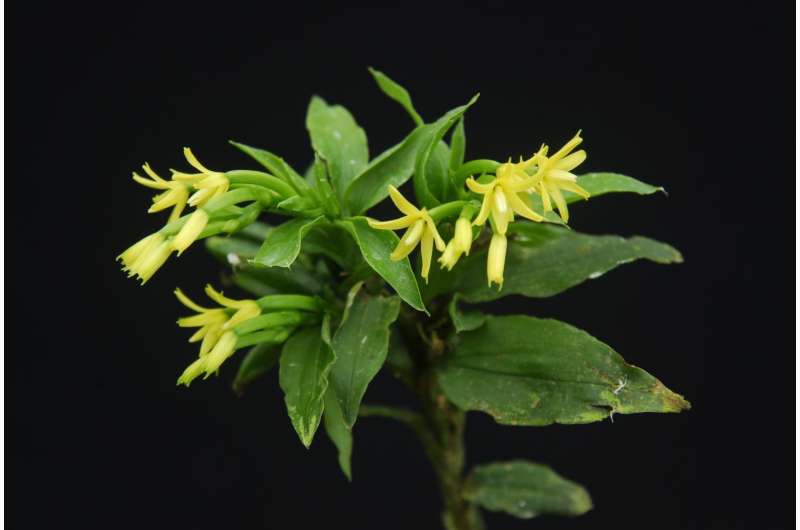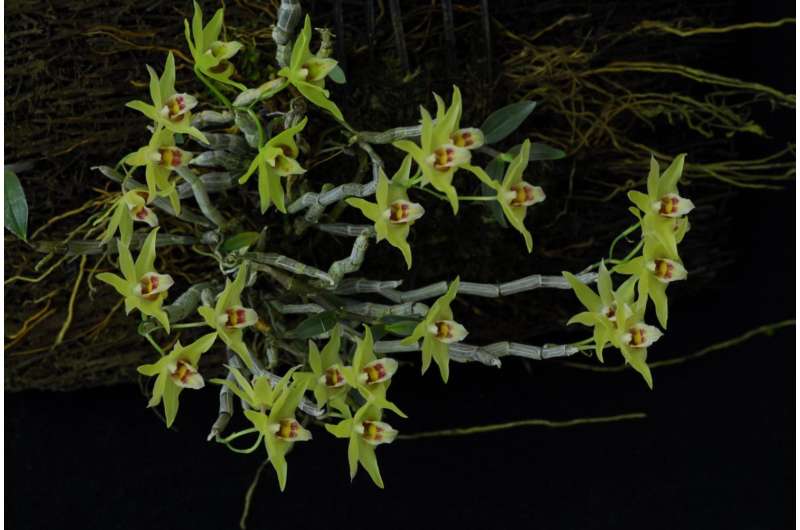A flowering plant of Apostasia shenzhenica Credit: Zhong-Jian Liu and Li-Jun Chen
(Phys.org)—A large international team of researchers has sequenced the genome of the orchid Apostasia shenzhenica. In their paper published in the journal Nature, the team describes the approach they used and what they learned during the process.
To say that orchids are prevalent in the world today is an understatement—as the researchers note, they currently constitute approximately 10 percent of all flowering plant species and have colonized all but the most extreme habitats on Earth. Because of its strong ability to migrate and change to suit diverse conditions, it has aroused the interests of scientists for many years. In this new effort, the researchers focused their work on Apostasia shenzhenica, a type of orchid found in southeast China. It is mostly green with yellow blossoms. Learning about the genomic makeup of the flower reveals the way it has evolved to adapt so well to new conditions.
The researchers report that they used 10x genomics scaffolding to conduct both short and long-read sequencing to develop a genome sequence for the plant. They report also that they used the results of their work to compare the plant with other orchids to isolate parts that were the same versus those that were different using transcriptome data.
The team found that A. shenzhenica offered strong evidence of its inclusion in the family of orchids—large parts of the genome were virtual copies of those of other orchid types. They also found, as suspected, that it split off from other orchids millions of years ago—close to the point in time when orchids first came to exist. They also found that orchids underwent a major extinction period after which the plants differentiated and subsequently evolved into five subfamilies. They suggest that it was during this period that features such as the famous "lip" developed.
The plants of Tie Pi Shi Hu Dendrobium catenatum (Epidendroideae) were growing on the tree. The whole genome of this species has been re-sequenced for this study. Credit: Zhong-Jian Liu and Li-Jun Chen
The team's findings suggest the plant is a good candidate for further research because it might offer evolutionary clues such as the factors that led to orchids having pollonia (masses of pollen) and lighter seeds than other plants. It might also explain another well-known trait—the ability to use other plants for support.
More information: Guo-Qiang Zhang et al. The Apostasia genome and the evolution of orchids, Nature (2017). DOI: 10.1038/nature23897
Abstract
Constituting approximately 10% of flowering plant species, orchids (Orchidaceae) display unique flower morphologies, possess an extraordinary diversity in lifestyle, and have successfully colonized almost every habitat on Earth. Here we report the draft genome sequence of Apostasia shenzhenica, a representative of one of two genera that form a sister lineage to the rest of the Orchidaceae, providing a reference for inferring the genome content and structure of the most recent common ancestor of all extant orchids and improving our understanding of their origins and evolution. In addition, we present transcriptome data for representatives of Vanilloideae, Cypripedioideae and Orchidoideae, and novel third-generation genome data for two species of Epidendroideae, covering all five orchid subfamilies. A. shenzhenica shows clear evidence of a whole-genome duplication, which is shared by all orchids and occurred shortly before their divergence. Comparisons between A. shenzhenica and other orchids and angiosperms also permitted the reconstruction of an ancestral orchid gene toolkit. We identify new gene families, gene family expansions and contractions, and changes within MADS-box gene classes, which control a diverse suite of developmental processes, during orchid evolution. This study sheds new light on the genetic mechanisms underpinning key orchid innovations, including the development of the labellum and gynostemium, pollinia, and seeds without endosperm, as well as the evolution of epiphytism; reveals relationships between the Orchidaceae subfamilies; and helps clarify the evolutionary history of orchids within the angiosperms.
Journal information: Nature
© 2017 Phys.org

























